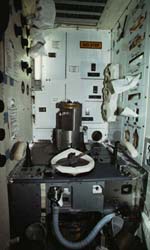





Personal
Hygiene:
When you get up it is good hygienic practice to take a shower or at
leas wash your hands before eating. A sleeping bag or bed are
warm and damp, due to a person's perspiration. These are conditions
that are favored by bacteria and micro fungus (molds). Theymultiply
in such conditions. You should therefore wash when you get up
and air your bed clothes to allow moistureto evaporate away.
Washing clothes and bed linen (or sleeping bags) removes bacteria and fungal infestations.
Hannah takes a shower.
Water is a valuable commodity on the Space Station. We have to recycle it, because we cannot just tap into the water main! That means that we have to clean the dirty water from the showers, the clothes washing, the dish-washingand even the toilets. We then recycle it, and use it again.
Have
you wondered how we do that? Visit Life
Support to find out.
The
recycling process has to remove all the solid,
floating matter in the water and all the dissolved chemicals that otherwise
might harm us.
These personal lockers aboard the space shuttle enable crew members to store their toiletries. © NASA, 1997
By
2020 the technology for living in space will be more developed than it
is now.
It will be more convenient to use and easier to maintain. So how
might our zero-g shower work in 2020?
There is a small bathroom unit in the habitat modules. When you use this you have to close and lock the door before any systems work. The door has an airlock seal. This is so any free water droplets are not released into the main Space Station. The unit is ventilated to draw any stray droplets and vapor into the recycling system.We bathe by taking a shower in a completely sealed booth. This has foot stirrups on the floor and hand rails on the wall to stop yourself drifting away in microgravity. High-power water sprays direct warm water on to you from several directions. In microgravity the water would float normally, and a person could easilydrown in the shower, so there is an air suction at the floor and a blowing system at the ceiling to force used water droplets out of the shower unit. Waste water is processed directly by the water recycling system, and in fact the shower is important in providing dilution for solid waste chemical concentrates.
We
use soap and shampoo in shower in the same way as on Earth, but this is
specially formulated to be compatible with
the re-cycling system. No personal toiletry items are allowed, and
this is something the crew often complains about.
|
(above)
Toilet aboard the Space Shuttle |
It
is advisable to wear a nose clip in shower to stop yourself breathing
water up your nose and I try and keep my mouth closed so I don't
get floating soapy water in it. We use towels to dry ourselves,
though the air blower system is quite effective at removing most
of the water. We have to get dry in the bathroom unit, so
we do not release water droplets into the main space station. There
is a water-tight locker we can store our towels and personal toiletries,
such as tooth brushes.
|
|
Each crew member can have a maximum of two showers per day.
We are each supplied with personal hygiene packs which contain all the necessary toiletries we need.We carry a large stock of these and we cancollect a new one from our stores each week. Toothbrushes and toothpaste are provided and these are the same as you would use in your bathroom. Any shaving has to be done in the shower, so that no minute hair particles are left drifting through the Space Station.
The
shower unit is supposed to be self-cleaning. It runs through a special
cleaning cycle after it has been used.
However,
I have recently found signs of mold growth around the foot stirrups.
What
should Henna do about the mold?
Clean
it herself
Ask the Facilities Manager to clean
it
Take a sample and test it
| Activitylink box | ||
 Make
a water recycling system Make
a water recycling system
|
 Make
a space washbasin Make
a space washbasin |
|
Go
to
Home
| Space Station
| Mars | Rainforest
© 1999 Satellite Events Enterprises Inc.
